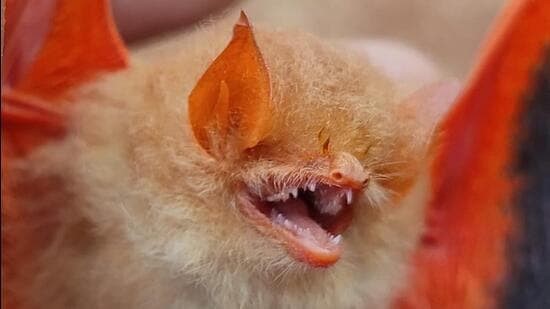Description

Disclaimer: Copyright infringement not intended.
Context: Chhattisgarh: Rare ‘orange bat’ spotted in Bastar’s Kanger Valley National Park. In India, it has already been spotted in the Western Ghats, Kerala, Maharashtra and Odisha, and now Chhattisgarh
Details:
- A rare orange-coloured bat, also known as ‘painted bat’ and characterised by bright orange and black wings was sighted.
- It is generally found in Bangladesh, Brunei, Burma, Cambodia, China, Indonesia, Malaysia, Nepal, Sri Lanka, Thailand and Vietnam.
- In India, it has already been spotted in the Western Ghats, Kerala, Maharashtra and Odisha, and now Chhattisgarh.
- The bat species has black wings and orange wings and fingers.
- Often found in unusual roosting sites such as suspended nests of weaver finches and sunbirds, banana leaves, these bats have been known to roost in pairs. It is an aerial hawker, catching insects mid-flight.
- The national park is famous for its limestone caves, which also provide a suitable habitat for the bats, experts say.
- There are about 131 species of bats in the country, of which 31 are found in central India.
.jpeg)
What are they?
- Bats are mammals belonging to the order Chiroptera, a name of Greek origin meaning "hand-wing," which accurately describes the animal's most unusual anatomical feature.
- The order is divided into two suborders, the Megachiroptera, consisting of a single family, the flying foxes and their Old World fruit and flower-eating relatives, and the Microchiroptera, composed of the rest of the bat families, some 17 in all.
- These families are further classified into about 180 genera and over 900 species; only rodents have a greater number of species.
- Although it is true that certain species of flying foxes have wingspans of up to 5 feet, one member of the Megachiroptera, the flower-feeding Macroglosus, has a wingspan of only 10 inches.
- However, some of the Microchiroptera are very tiny; the smallest is probably the Philippine bamboo bat, Tylonycteris pachypus, its forearm measuring only 22mm. and weighing only 0.05 ounce. The largest Microbat is the tropical American false vampire, Vampyrumspectrum, with a wingspan of up to 40 inches.
Where are they?
- Because bats are small, secretive, feed at night, and are unfamiliar to most people, they are sometimes regarded as rare.
- On the contrary, they are found throughout the world except for certain oceanic islands, the Arctic and Antarctic.
- Though most species inhabit the tropical and semitropical areas of the world, they are still common in the United States and are most numerous in the Southwest.
- Some bats prefer to roost in barns, attics, caves or abandoned mines, those shelters providing safety from predators, protection from fluctuations in weather, and seclusion for rearing the young.
- Other species select hollow trees or rock crevices as their daytime resting site, while certain ones are known to roost in exposed locations, clinging to tree trunks or hanging upside down from tree branches.
- To survive in colder regions, bats either hibernate in shelters with high humidity and temperatures above freezing, or migrate to warmer areas where food is available.
When did they appear?
Evidence for bat-like flying mammals appears as far back as the Eocene Epoch, some 50 million years ago; however, the fossil record tracing bat evolution is scanty.

How do they fly?
- Even though they share the characteristics of all mammals - hair, regulated body temperature, the ability to bear their young alive and nurse them - bats are the only mammals to truly fly.
- Only bats have the structural adaptations that allow for full powered flight.
What do they eat?
- "Blind as a bat" is a common saying yet one that is false. All bats can see, even though vision may be less important than other senses.
- To locate and catch prey, insectivorous bats use an acoustic orientation called echolocation. They emit a series of supersonic cries through the mouth or nose and detect flying insects by the echoes reflected back.

https://www.hindustantimes.com/cities/others/chhattisgarh-rare-orange-bat-spotted-in-bastar-s-kanger-valley-national-park-101674107037180.html












